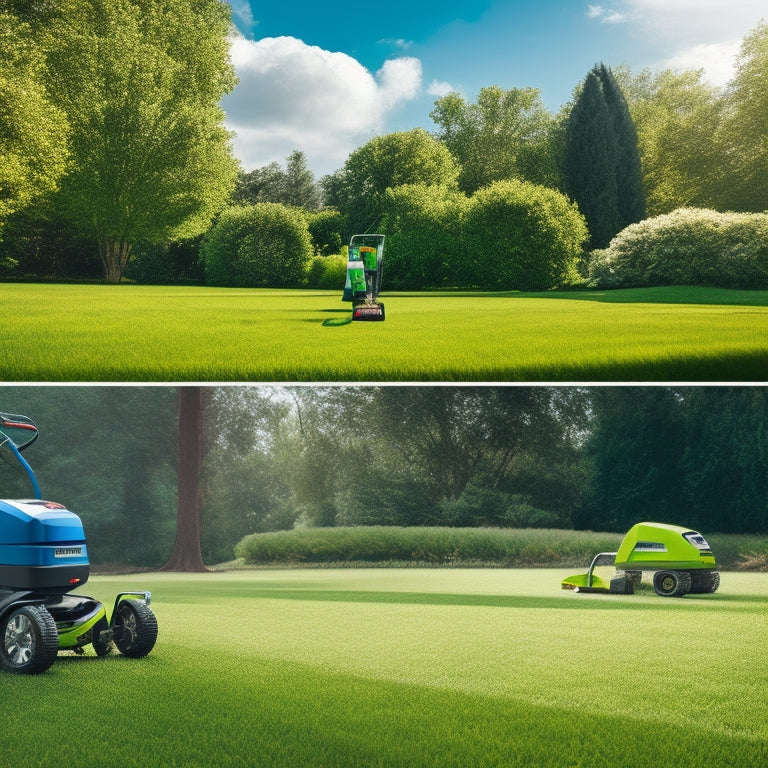
Maximize Runtime: Choose Powerful Battery Lawn Tools
Share
To maximize runtime and tackle your yard work efficiently, you'll want to choose powerful battery lawn tools that meet your specific needs. Start by considering the power output, measured in volts and amps, as well as battery compatibility to save costs. Look for tools with high energy density, long cycle life, and advanced charging technologies like rapid or smart charging. Additionally, prioritize energy efficiency, eco-friendly practices, and proper battery maintenance to extend tool longevity. By understanding these key features, you'll be well on your way to selecting the perfect battery lawn tools for your yard - and there's more to investigate to get the most out of your investment.
Key Takeaways
- Choose lithium-ion batteries for high energy density, low self-discharge, and long cycle life to maximize runtime.
- Select tools with high voltage and amp ratings for greater power output and efficiency in tackling tough tasks.
- Opt for tools with advanced charging technology, such as rapid or smart charging, to reduce downtime between tasks.
- Consider tools with high energy density ratings, as they store and release energy more efficiently, impacting performance and runtime.
- Prioritize tools with efficient power output, torque, and speed to enhance energy efficiency, reduce maintenance costs, and maximize runtime.
Key Features to Look For
When shopping for powerful battery lawn tools, you're likely to encounter a plethora of options, each boasting its unique set of features. To make an informed decision, you need to know what to look for.
First, consider the tool's power output, measured in volts and amps. A higher voltage usually translates to more power, but also reduces runtime. Next, check the battery's compatibility with other tools from the same manufacturer. This can save you money in the long run.
Additionally, look for battery maintenance tips and seasonal storage practices to guarantee your tool lasts longer. Moreover, sustainable energy solutions can also be applied to lawn tools, promoting eco-friendly practices. By considering energy-efficient options, you can reduce your carbon footprint while maintaining a well-manicured lawn.
Battery Type and Capacity
Your battery lawn tool's performance hinges on its battery type and capacity. You want a battery that provides reliable power, long runtime, and efficient charging. When choosing a battery, take into account the following key factors:
- Lithium-Ion (Li-ion) batteries: They offer high energy density, low self-discharge, and long cycle life, making them the most popular choice for battery lawn tools.
Installing solar-powered charging stations for your tools can lead to considerable energy savings, with estimated annual savings of $500 to $2,000+, reducing electricity bills and enhancing sustainability.
- Battery capacity (Ah): A higher capacity means longer runtime, but it also increases the battery's size and weight.
Look for a capacity that balances your needs with portability. It's crucial to evaluate the complexity of the installation, accessibility, and permits required, as these factors can influence the overall cost of the charging station.
- Charging technology: Advanced charging systems, like rapid charging or smart charging, can greatly reduce charging time and improve battery longevity.
Power and Performance Metrics
When evaluating powerful battery lawn tools, you're likely to encounter metrics that affect their performance.
You'll want to take into account voltage and amps, as they directly impact the tool's power output, as well as torque and speed, which influence its ability to tackle specific tasks.
Energy efficiency is also essential, as it can reduce operating costs and environmental impact, much like solar roofing systems do for box trucks and vans.
Additionally, understanding energy density ratings, which indicate how efficiently the battery stores and releases energy, is important for ideal tool performance.
Voltage and Amps Matter
As you investigate the world of battery lawn tools, understanding the importance of voltage and amps becomes essential, for these metrics dictate the power and performance of your equipment.
These two factors directly impact the efficiency and effectiveness of your lawn care tasks.
When evaluating battery lawn tools, consider the following key aspects of voltage and amps:
-
Voltage: A higher voltage generally translates to more power output, allowing you to tackle tougher tasks. Look for tools with higher voltage ratings (e.g., 40V or 80V) for increased performance.
-
Amp-hours (Ah): This measures the battery's capacity to store energy. Higher Ah ratings typically mean longer runtime and more power available for your tasks.
-
Battery chemistry: The type of battery chemistry used (e.g., lithium-ion or lead-acid) affects power output, durability, and overall performance.
Torque and Speed Counts
Three key metrics - torque, speed, and power - play an essential role in determining the performance of your battery lawn tools.
When choosing a tool, you'll want to take into account these metrics to guarantee you're getting the most out of your device. Torque measures the rotational force of your tool, which affects its ability to cut through thick grass or dense brush.
Proper battery recycling practices can also extend the life of your tools and reduce waste. Additionally, understanding the costs associated with battery recycling, such as the $0.20 - $0.30 per pound cost for lithium-ion batteries, can inform your purchasing decisions.
Speed, on the other hand, determines how quickly you can complete a task. Look for tools with high torque and speed ratings to maximize your efficiency.
Additionally, take into account tools with high power ratings, which indicate their overall energy output. By prioritizing these metrics, you'll be able to tackle tough landscaping tasks with ease, while also enjoying improved energy efficiency and lower maintenance costs.
Energy Density Rating
Five key performance metrics, including energy density rating, voltage, and current, further refine your understanding of a battery lawn tool's capabilities.
Energy density rating, in particular, is vital as it measures the amount of energy stored per unit of weight and volume. A higher energy density rating indicates better energy efficiency, which translates to longer runtime and battery longevity.
In the same way that electric vehicles can save up to $14,500 on fuel costs over 15 years fuel cost savings, a higher energy density rating can lead to significant savings on energy consumption.
To give you a better idea, consider the following:
- Higher energy density means more power in a smaller, lighter package.
- Improved energy efficiency reduces the tool's energy consumption, allowing for longer runtime.
- Increased battery longevity results from reduced wear and tear on the battery, extending its lifespan.
Tool Weight and Ergonomics
When you're working with powerful battery lawn tools, you'll quickly realize that tool weight and ergonomics play an essential role in your overall efficiency and comfort.
A balanced design matters, as it allows you to maneuver the tool with ease, reducing fatigue and strain.
You'll also appreciate a grip that's comfortable to hold, as it enables you to maintain control and precision throughout your tasks.
Balanced Design Matters
Your comfort and control while working in the yard depend on a delicate balance of tool weight and ergonomics. A well-designed tool should feel comfortable in your hands, allowing you to work efficiently without fatigue. This balance is essential, as it directly impacts your productivity and overall experience.
When evaluating tool weight and ergonomics, consider the following key factors:
-
Weight distribution: Look for tools with evenly distributed weight, making them easier to maneuver and reducing strain on your body.
-
Aesthetic appeal: A tool's design shouldn't only be functional but also visually appealing, enhancing your confidence and motivation to tackle yard work.
-
Ergonomic contours: Tools with contoured grips and handles should fit comfortably in your hands, reducing fatigue and discomfort during extended use.
Grip Comfort Counts
One essential aspect of a well-balanced tool design is grip comfort, which greatly impacts your overall experience with battery lawn tools.
You'll appreciate the difference a comfortable grip makes when working on your lawn for extended periods. Look for tools with grip materials that provide a secure hold, even in wet conditions.
An ergonomic design guarantees the tool fits comfortably in your hand, reducing fatigue and strain.
When choosing a battery lawn tool, consider the weight distribution and balance. A well-balanced tool with a comfortable grip allows you to work efficiently, enjoying the freedom to tackle your lawn care tasks without hassle.
Charging Time and Efficiency
With the battery's capacity to store energy comes the importance of efficient charging.
You want to get back to mowing, trimming, and edging as quickly as possible. Advances in charging technology have markedly reduced charging times, giving you more freedom to tackle your outdoor tasks.
Here are three key considerations for ideal charging:
-
Smart Charging: Look for chargers with built-in sensors that monitor battery health and adjust charging rates accordingly.
-
Rapid Charging: Some chargers can replenish batteries to 80% in under 30 minutes, perfect for quick top-ups.
-
Cooling Systems: Some chargers incorporate cooling systems to prevent overheating, ensuring safer and more efficient charging.
Runtime and Cycle Life
Battery runtime and cycle life are critical factors in determining the overall performance of your power tools. When choosing a battery lawn tool, you want to make sure it can handle your workload without needing frequent recharging. A longer runtime means you can complete tasks efficiently, while a longer cycle life means your battery will last longer.
| Battery Type | Runtime Optimization |
|---|---|
| Lithium-Ion | Up to 40% longer runtime due to higher energy density |
| Nickel-Cadmium | Improved battery longevity through reduced memory effect |
| Lead-Acid | Enhanced cycle life with advanced charging algorithms |
Compatibility and Expandability
You've selected a battery lawn tool with a suitable runtime and cycle life, but now it's time to contemplate how it fits into your overall equipment ecosystem.
Consider the compatibility of your tool with other products from the same battery brand. Will you be able to share batteries across tools, reducing clutter and increasing convenience?
To guarantee seamless integration, look for tools with:
-
Tool compatibility: Check if the tool is compatible with other devices from the same brand, allowing for shared batteries and charging systems.
-
Expansion options: Consider tools with modular designs, enabling you to add accessories or upgrade components as needed.
-
Platform integration: Opt for tools that integrate with a larger platform, providing access to a range of compatible products and accessories.
Frequently Asked Questions
Can I Use My Existing Charger With New Battery Lawn Tools?
You'll need to check if your existing charger is compatible with new battery lawn tools to avoid reducing battery lifespan; verify the voltage, amp, and connector match to secure seamless charging and ideal performance.
Are Battery Lawn Tools Suitable for Large Commercial Properties?
You've seen how GreenWorks, a commercial landscaping company, effortlessly maintains 50-acre properties using high-capacity battery lawn tools with strong power output and runtime efficiency, allowing you to tackle large commercial properties without downtime.
How Do I Store Battery Lawn Tools During the Off-Season?
When the off-season arrives, you'll want to store your battery lawn tools properly to maintain their performance; clean and dry them, store in a cool dry place, and keep batteries charged at 50% to guarantee ideal battery maintenance.
Are Battery Lawn Tools More Environmentally Friendly Than Gas-Powered?
You'll be intrigued to know that 1 in 5 Americans still uses gas-powered lawn mowers, contributing to air pollution. By switching to battery lawn tools, you'll experience emission reduction and energy efficiency, ultimately freeing you from environmental guilt and noise pollution.
Can I Use Battery Lawn Tools in Wet or Rainy Conditions?
You can use battery lawn tools in wet or rainy conditions if you take safety precautions, ensuring your tools have adequate moisture protection, such as waterproof batteries and sealed connections, to prevent electrical shock or damage.
Related Posts
-

Sustainable Scrubbing: Top Bathroom Solutions for Earth-Conscious Homes
You're taking an important step towards creating a more sustainable home by switching to eco-friendly bathroom cleani...
-

What Does Your Home Energy Audit Report Reveal?
Your home energy audit report reveals a detailed analysis of your energy consumption patterns, highlighting areas of ...
-

What Roofing Materials Best Protect Our Planet?
As you consider the environmental impact of your building, you're likely to find that the roofing material you choose...


